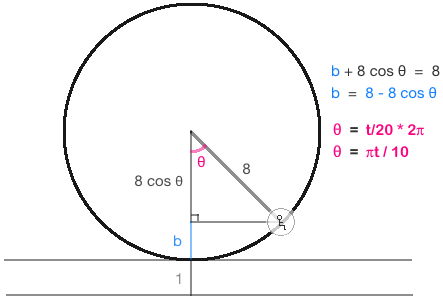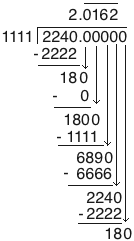1.
distance between (1, 1) and (4, 7) = \(\sqrt{(4-1)^2+(7-1)^2}\ =\ \sqrt{9+36}\ =\ \sqrt{45}\ =\ 3\sqrt5\)
2.
| Let x be the thickness of the walls in feet. | |
| (12 - 2x)(17 - 2x) = 176 |
|
| 204 - 24x - 34x + 4x2 = 176 | |
| 4x2 - 58x + 204 = 176 |
|
| 4x2 - 58x + 28 = 0 | |
| 4x2 - 2x - 56x + 28 = 0 |
|
| 2x(2x - 1) - 28(2x - 1) = 0 | |
| (2x - 1)(2x - 28) = 0 |
|
| x = 1/2 or x = 14 | |
| x can't be 14 because that would make the walls thicker than the dimensions of the exterior of the room. |
|
| x = 1/2 is the solution. |
a)
Maybe this drawing will help...
The thing at the bottom right corner of the triangle is supposed to be somebody riding the Ferris wheel x)
All the lengths are in meters, and t is the number of seconds after the ride starts.

height of person = b + 1
height of person = 8 - 8 cos θ + 1
height of person = 9 - 8 cos θ
height of person = 9 - 8 cos( \(\frac{\pi t}{10}\) )
h(t) = -8 cos( \(\frac{\pi t}{10}\) ) + 9
If you have a question about where any part of this came from, please ask ![]()
Here is a cool graph: https://www.desmos.com/calculator/csy92axqeq
You can choose the value of t using the slider and see where the point representing the person is at.
Also, you can turn on the folder called "graph of height" to see a graph of y = -8 cos( \(\frac{\pi x}{10}\) ) + 9

n1 = 0
n2 = 1
n3 = 6
n4 = 2
nk = n(k mod 4) and n0 = n4
| 1000n16 | _+_ | 100n13 | _+_ | 10n10 | _+_ | n7 | ||
| =__ | 1000n4 | + | 100n1 | + | 10n2 | + | n3 |
|
| = | 1000(2) | + | 100(0) | + | 10(1) | + | 6 | |
| = | 2000 | + | 0 | + | 10 | + | 6 |
|
| = | 2016 |